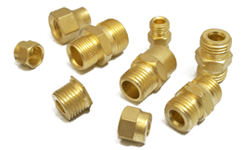Brass Compression Fittings are used in plumbing and electrical conduit systems to join two tubes or thin-walled pipes together. In instances where two pipes made of dissimilar materials are to be joined, the fittings will also be made of Brass or more compatible materials appropriate for the connection. Compression fittings for attaching tubing (piping) commonly have ferrules in them.
Brass Compression fittings are also used extensively for hot and cold water faucets (taps) and toilet stop valves; compression fittings are well suited to this application, as these valves are usually located in confined spaces where the copper pipe would be difficult to solder without creating a fire hazard. Compression fittings are the industry standard for chemical, oil, and gas, R&D, Biotech, and the semiconductor industry. They are used due to their ability to provide leak-tight seals. These fittings can be remade. The compression fitting is composed of an outer compression nut and an inner compression ring, or ferrule that is usually made of brass. Ferrules vary in shape and material but are most commonly in the shape of a ring with beveled edges and they are most commonly made out of brass or according to the pipe material. To work properly, the ferrule must be oriented correctly; typically the ferrule is fitted such that the longest sloping face of the ferrule faces away from the nut.
When the nut is tightened, the ferrule is compressed between the nut and the receiving fitting; the ends of the ferrule are clamped around the pipe, and the middle of the ferrule bows away from the pipe, making the ferrule effectively thicker. The result is that the ferrule seals the space between the pipe, nut, and receiving fitting, thereby forming a tight joint.
It is important to the integrity of a compression fitting that excessive force be avoided when tightening the nut. If the nut is over-tightened, the ferrule frequently deforms improperly causing the joint to fail. Indeed, over-tightening is the most common cause of leaks in compression fittings. A good rule of thumb is to tighten the nut first by hand until it is too difficult to continue and then tighten the nut a half-turn more with the aid of a wrench; the actual amount varies with the size of the fitting, as a larger one requires less tightening. The fitting is then tested: If slight weeping is observed, the fitting is slowly tightened until the weeping stops.
Jamnagar industries produce all types of compression fitting as per customer’s specification & supply with all assembly.
We are also producing all types of Brass tube, pipe, barb, and joint fittings as per customers' specifications.
All the operation of forging, machining & final finishing facilities at one place called Jamnagar Industry's
Details
| Material | High-Grade Brass, Graded Mild Steel | |
| Threaded | ISO Metric, BS, UNF, NPT OR AS PER REQUIRE | |
| Final Finish | As require. |
Tags:
Product


